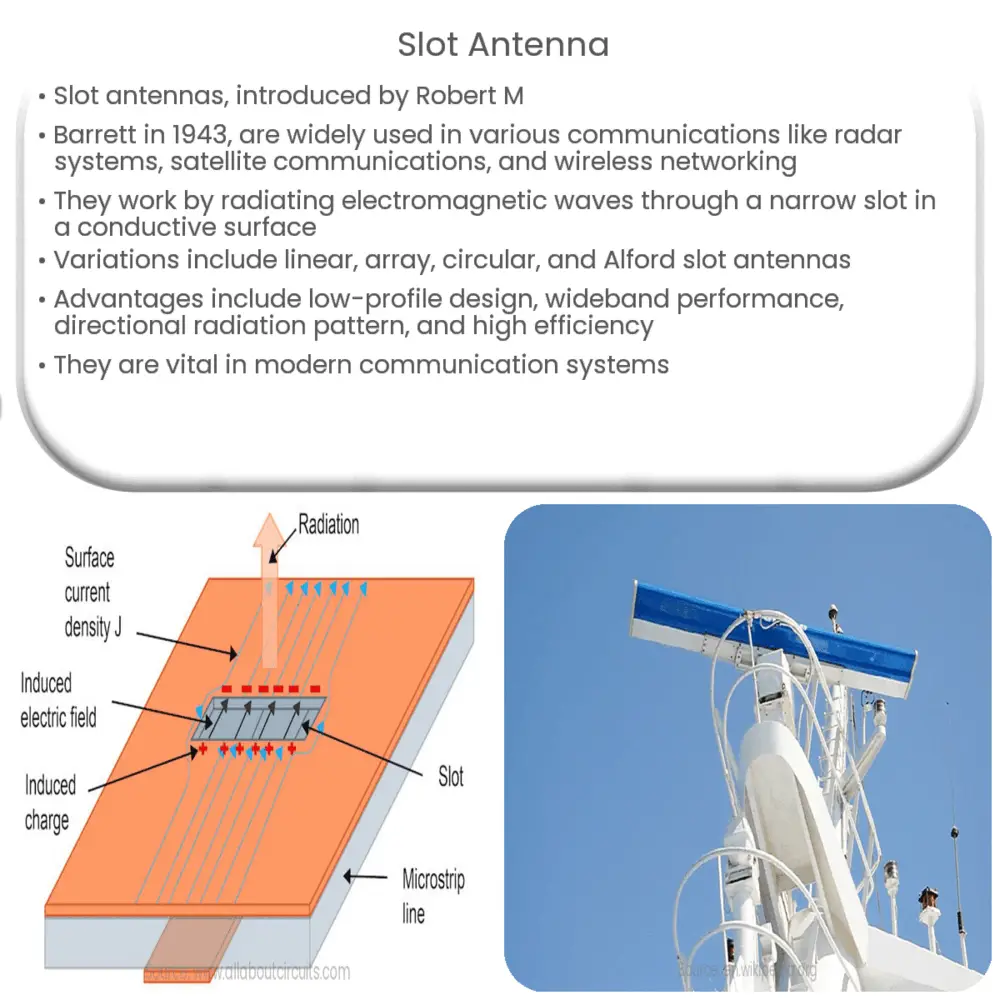Slot antennas are low-profile, wideband antennas with directional radiation patterns, used in radar, satellite communication, Wi-Fi, and TV broadcasting.

Slot Antenna: An Introduction
What is a Slot Antenna?
A slot antenna is a type of directional antenna that radiates electromagnetic waves through an elongated, narrow slot or aperture cut into a conductive surface, typically a flat metal sheet or plate. This type of antenna is widely used in various communication applications, including radar systems, satellite communications, and wireless networking.
History of the Slot Antenna
The slot antenna was first introduced in 1943 by Robert M. Barrett, an engineer at the Massachusetts Institute of Technology (MIT) during World War II. Barrett discovered the concept of the slot antenna while working on radar systems, and it quickly became an essential technology for military applications. Over time, the slot antenna has evolved and found its way into numerous commercial applications, such as satellite communications, wireless networking, and broadcast television.
How Does a Slot Antenna Work?
The fundamental principle behind a slot antenna is that it functions as the dual of a dipole antenna. In a dipole antenna, current flows through two rods or wires, creating an electric field that radiates electromagnetic waves. In a slot antenna, the current flows around the edges of the slot or aperture, resulting in a magnetic field that radiates the electromagnetic waves.
The size and shape of the slot determine the operating frequency and radiation pattern of the antenna. Typically, the length of the slot is approximately half the wavelength of the desired operating frequency. This length is important because it ensures the antenna is resonant, allowing it to efficiently transmit and receive signals.
Types of Slot Antennas
There are several different types of slot antennas, with variations in the slot shape, antenna size, and feed mechanism. Some common types include:
- Linear Slot Antenna: Features a single, straight slot cut into a conductive surface. This type is often used in radar systems and satellite communications.
- Slot Array Antenna: Consists of multiple linear slot antennas arranged in a specific pattern to create a larger, more directional radiation pattern. These are commonly used in wireless networking and satellite communication applications.
- Circular Slot Antenna: Uses a circular slot to produce a radiation pattern with low sidelobe levels. This type is often used for satellite communications and radar systems.
- Alford Slot Antenna: A specialized type of slot antenna that uses a folded slot to improve its impedance matching characteristics. This design is used in various communication systems, including broadcast television.
Advantages of Slot Antennas
Slot antennas offer several advantages over other types of antennas, making them suitable for a wide range of applications:
- Low-profile design: The flat, planar nature of slot antennas allows them to be easily integrated into various structures or surfaces, such as aircraft, satellites, and building exteriors.
- Wideband performance: Slot antennas can operate over a broad frequency range, providing flexibility in applications that require simultaneous operation at multiple frequencies.
- Directional radiation pattern: Slot antennas produce a directional radiation pattern, which is ideal for point-to-point communication systems and helps reduce interference from other signals.
- High efficiency: Due to their resonant design, slot antennas can efficiently transmit and receive signals, leading to improved overall system performance.
Applications of Slot Antennas
Slot antennas have found their way into a wide variety of applications, including:
- Radar systems: Due to their directional radiation pattern and wideband performance, slot antennas are commonly used in radar systems for aircraft, ships, and ground-based installations.
- Satellite communications: Slot antennas are often used in satellite communication systems, where their low-profile design and high efficiency are critical for minimizing size and weight constraints.
- Wireless networking: Slot array antennas are commonly used in wireless networking equipment, such as Wi-Fi access points and base stations, to provide directional coverage and improved signal strength.
- Broadcast television: Alford slot antennas are frequently used in broadcast television systems, where their impedance matching characteristics and wideband performance are essential for transmitting and receiving television signals.
Conclusion
Slot antennas play a crucial role in many communication systems, offering numerous advantages over other antenna types. Their low-profile design, wideband performance, and directional radiation pattern make them an ideal choice for applications ranging from radar systems to wireless networking. As technology continues to advance, it is likely that slot antennas will continue to be a critical component in the evolution of modern communication systems.

